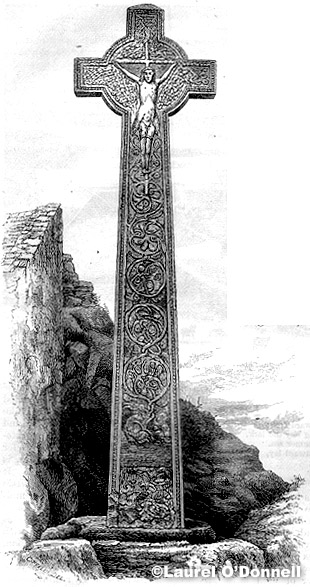|
|
Colonsay and Oronsay.,
Page 3 of 4 
Left: The Oronsay Cross
Colonsay, with Oronsay, a small island united with it at low tide, and belonging to the same owner, contains about ten thousand acres. It is emphatically the land of the "hill and the heather." A small part only can be said to be arable, but nearly the whole may be considered productive. The cultivated fields produce oats, barley, hay, turnips, and other root crops. The garden vegetables, with berries, such as the strawberry and gooseberry, are produced in abundance. There is much rain, but little snow, and frost seldom strikes into the ground more than three or four inches in the severest winter. The heather-covered hills show large plots of thick matted grasses, green all the year round, owing to the springy soil and abundance of rain-fall; and on these hill ranges the hardy black-faced sheep find food daring almost the entire year, and herds of the Highland black-cattle graze with but partial interruption during winter. The house of the laird-and the only one of any pretension on the island -is of stone, and large and commodious, surrounded 'with handsome gardens and ample pleasure-grounds. The houses of tenant-farmers are all of stone, many of them recently built, and all around there is a general air of comfort and thrift. In many of the islands composing the Hebrides group are found small, beautiful lakes, well stocked with trout and other table fish. There is such a lake in Colonsay, and in the centre a small island, covered with what may have been in early times a rude fortification, and where, it is said, the women and children were placed, for protection when there was threatened invasion from other islanders or rovers on the sea. Days were spent, in company with Commander Stewart, in driving and walking around the island, rowing on the lake, or sitting perched on high cliffs, watching the stormy-Atlantic, as its waves came tumbling and beating against the rocks, two hundred feet below us. But the most interesting excursion was to the adjoining island of Oronsay. This, as well as Iona, may be termed a sacred island; for here, it is claimed, the pure Gospel was preached by the Culdees centuries ago. Here, around the crosses which they set up, and in the shadow of the crumbling walls of their sacred edifices, repose the ashes of bishops and deacons, presbyters and priests, mingled with those of humble citizens and armed warriors, all awaiting the final resurrection. The principal cross — said to be the finest of its kind in Scotland —is still perfect and erect, having successfully resisted the beatings of the storms for ages. Here, as in many places in old settled countries, may be seen the strange commingling of the living and the dead-young, vigorous, active life laboring, singing, and rejoicing around old and venerated places, sanctified by the devotions and religious labors of former inhabitants. In one of the views given will be seen the farm-house of Oronsay, with its out-buildings coming close up and almost surrounding the sacred ruins. The Oronsay tradition is that on this spot Columba landed from Ireland, and here first planted the |
|
3
Books & articles appearing here are modified adaptations
from a private collection of vintage books & magazines. Reproduction of these pages is prohibited without written permission. © Laurel O'Donnell, 1996-2006.
|
|


